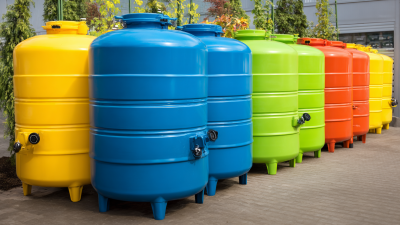Water tanks play a crucial role in promoting sustainable living, providing a reliable source of water for various needs while reducing dependence on municipal supply systems. With global water scarcity affecting over 2 billion people according to the United Nations, the implementation of efficient water storage solutions is more important than ever. Water tanks offer numerous benefits, including rainwater harvesting, which can reduce stormwater runoff and minimize flooding risks. Additionally, a report by the World Resources Institute highlights that the use of water tanks can improve water security and resilience in communities, particularly in arid regions. By understanding the significance of water tanks, individuals and communities can adopt best practices for their installation and maintenance, thus contributing to environmental sustainability and resource conservation.

Water tanks play a crucial role in promoting sustainable living, particularly for households seeking to reduce their environmental impact. According to a study by the World Health Organization, approximately 2.2 billion people globally lack access to safely managed drinking water, making efficient water storage solutions essential. By installing a water tank, households can collect and store rainwater, which can reduce reliance on municipal water sources and lower water bills by up to 50%, as cited by the Environmental Protection Agency (EPA).
Moreover, the use of water tanks contributes to the effective management of stormwater runoff, which is a significant concern in urban areas. The National Oceanic and Atmospheric Administration (NOAA) reports that rainwater harvesting can help to mitigate flooding and erosion, as collected rainwater can be gradually released into the environment. This practice not only conserves water but also enhances local ecosystems by replenishing groundwater supplies. Thus, water tanks are not just storage solutions; they are integral to fostering a resilient and sustainable community.
Choosing the right location for your water tank installation is crucial for maximizing its efficiency and ensuring it serves your needs effectively. When selecting a site, consider proximity to water sources, such as gutters or downspouts, to facilitate easy collection of rainwater. A flat, stable area is ideal, as it minimizes the risk of tipping or structural stress on the tank. Additionally, ensure that the location is accessible for future maintenance and potential expansion.
Sunlight exposure also plays a significant role in the longevity of your water tank. Placing it in a shaded area can help prevent water heating, which can lead to algal growth and contamination. Furthermore, the tank should be positioned away from trees to avoid debris buildup that can clog filtration systems. Lastly, local regulations regarding water tank placement should be consulted to ensure compliance and avoid any potential legal issues.

Effective water collection techniques are essential for maximizing efficiency in sustainable living. One of the most common methods is rainwater harvesting, where systems are installed to capture and store rainwater from rooftops. This technique not only reduces dependence on municipal water supply but also alleviates stormwater runoff, which can lead to flooding and water quality issues. Utilizing gutters and downspouts connected to storage tanks allows homeowners to stockpile water for later use, particularly during dry spells.
Moreover, employing filtration systems can enhance the quality of collected rainwater, making it safe for various uses, such as irrigation and toilet flushing. Another effective method is the use of graywater systems, which recycle water from sinks, showers, and laundry for irrigation purposes. These simple yet innovative techniques contribute significantly to water conservation, making them integral to sustainable living practices. By implementing these efficient water collection techniques, individuals can significantly reduce their environmental footprint while ensuring a reliable water source for their everyday needs.
| Aspect | Details | Benefits | Best Practices |
|---|---|---|---|
| Water Collection Techniques | Rainwater harvesting systems, surface runoff collection | Reduces dependency on municipal water supply | Regular maintenance of collection systems |
| Tank Size Selection | Depends on household size and usage | Optimizes water storage for needs | Calculate average water usage |
| Material Types | Plastic, concrete, fiberglass, metal | Durability and suitability for various climates | Choose material based on local conditions |
| Water Quality | Filtering systems to remove contaminants | Ensures safe water for consumption | Regular water testing and treatment |
| Cost Savings | Lower utility bills through reduced consumption | Economic benefits over time | Monitor water usage to identify savings |
Maintaining water tanks is crucial for ensuring the longevity and efficiency of your sustainable living practices. Regular maintenance helps prevent contamination and ensures that the water stored is safe and clean for various uses. One of the key practices is to inspect the tank periodically for leaks or dents, which can compromise its structure. Additionally, clearing any debris, such as leaves and dirt, from the inlet and outlet areas helps to maintain a clear pathway for water flow and prevents blockages.

Tips: Consider setting a maintenance schedule to check your water tank at least twice a year. This includes cleaning the tank and checking the water quality. Another important step is to ensure your tank is securely covered to protect against contaminants and pests. Installing a filtration system can also be beneficial, as it enhances the quality of water collected from rain or other sources.
By implementing these maintenance practices, you can extend the life of your water tank, ensuring it remains a reliable resource in your journey towards sustainable living. Regular care not only enhances functionality but also contributes to the overall health of your household and environment.
Integrating water tank systems with other sustainable practices is essential for creating a resilient and eco-friendly living environment. One effective approach is combining rainwater harvesting with greywater recycling. By capturing rainwater from roofs for non-potable uses, such as irrigation or toilet flushing, households can significantly reduce their dependence on municipal water supply. Greywater, which includes wastewater from sinks and showers, can also be treated and reused in the garden, maximizing the water efficiency of the home's ecosystem.
Moreover, the use of permeable surfaces in landscaping can help manage stormwater runoff while enhancing the efficiency of water tank systems. These surfaces allow rainwater to infiltrate the ground, reducing erosion and replenishing groundwater supplies. Planting native vegetation around water tanks not only supports local biodiversity but also minimizes water requirements for landscaping, creating a harmonious balance between water conservation and biodiversity protection. Together, these practices create a holistic approach to sustainable living, where water management integrates seamlessly with the broader environmental goals.






